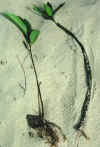Mangroves
Mangrove forests or swamps can be found on low, muddy,
tropical coastal areas around the world. Mangroves are woody plants that form the
dominant vegetation of mangrove forests. They are characterized by their prop roots,
their ability to tolerate regular inundation by salt water, and by precocious
(pre-dispersal) germination of their seeds and development of their seedlings. Woody
plants sharing these adaptations are all called mangroves although not closely related;
the mangroves below belong to Rhizophoraceae, Meliaceae, and Verbenaceae.
Mangrove forests form along the banks of estuarine rivers.
They form dense thickets of prop roots and aerial stems, which in turn trap
sediments and move the shallow mud flats and delta areas seaward. The mud, stems,
and roots make excursions into mangroves difficult, a real biological adventure.
Mangroves are highly productive areas contributing to the
food chains of coastal oceanic areas. The biomass and diversity of invertebrates per
unit area of mangroves and adjacent mud flats is very high. Seabirds using mangroves
as rookeries and by depositing their guano, they return valuable nitrogen from the oceans
to the mangrove forest. Many oceanic organisms rely on mangroves for part of their
life cycle, so mangroves are nurseries for ocean fisheries. The thick mangrove
forests also protect low coastal areas in storms. However, humans have tended to
look upon mangrove swamps as useless vegetation blocking their access to the coast, so
mangroves have been destroyed in many areas by human development. Given the key
position mangrove forests in the life cycles and food chains of coastal oceans, this
destruction will have an adverse affect on coastal fisheries.
The photographs displayed below were taken in mangrove
forests in Thailand and Australia, or cultivated specimens in the ISU plant
collection.
The images displayed on this page are the property of
Joseph E. Armstrong. They may be used for noncommercial, educational purposes with my
permission. Click here to send an e-mail message
to Prof. Armstrong.

Mangrove forest on banks of estuarine mudflats. |

Mangroves between shore and rain forest trees to rear. |

Mangrove understory thick with stems and prop roots. |

Aerial roots called rhizophores or pneumatophores. |

Dense understory on inland side of mangrove forest. |

Seedlings of Avicennia (2 sp.) washing up on shore. |

Xylocarpus and Rhizophora (right) seedlings on shore. |

Mangrove seedlings taking root on mud flat at forest margin. |

Young mangrove seedlings on open mudflat. |

Young mangroves showing early prop root development. |

Small blue crabs outside their burrows among mangrove seedlings. |

Mudskippers in a puddle within the mangrove forest. |

Flowers of Avicennia, (Verbenaceae) black mangrove. |

Flowers of Rhizophora mangle, red mangrove.
|

Leaf ants making and guarding a nest in the mangroves. |
|

At high tide the mangroves flood. |

Shark foraging among mangrove roots at high tide. |
|
|
|
Return to Armstrong's Main Menu Page.














